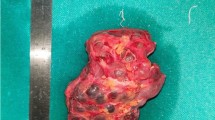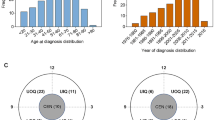Abstract
Objective
To explore the clinicopathologic features of secretory carcinoma of breast (SCB).
Methods
Four cases of SCB were analyzed by light microscopy, histochemistry, immunohistochemistry and electron microscopy. The clinical data were also analyzed. Special staining of periodic acid-Schiff reaction with diastase pretreatment, immunohistochemical staining of ER, PR, HER-2, p53, MIB-1, S-100, p63, CK8/18 and EMA by En Vision method were performed.
Results
Solid, cribriform, tubular, or papillary architecture may be seen. Tumor forms cystic spaces filled with abundant pale pink secretory material, positive with diastase resistant periodic acid-Schiff (PAS-DR) stains. Tumor cells were small with bland nuclei and abundant pale, eosinophilic cytoplasm, rare mitotic activity and necrosis. Immunohistochemically, tumor cells were positive for CK8/18, EMA, negative for S-100, p63 and variable partially positive for p53, ER, PR, HER-2 and MIB-1. Under electron microscopy, the tumor cells possessed numerous membrane-bound secretory vacuoles in cytoplasm lined by microvilli.
Conclusion
SCB is a rare, low-malignant neoplasm. SCB have pathology, clinical picture, treatment, follow-up, immunohistochemical and genetic features that distinguish them from invasive ductal carcinomas of the usual type.
Similar content being viewed by others
References
Yaqoob N, Kayani N, ul Hasan SH. Painless breast lump in an elderly woman. Secretory breast carcinoma in an elderly woman. Arch Pathol Lab Med, 2006, 130: 1073–1074.
Ozguroglu M, Tascilar K, Ilvan S, et al. Secretory carcinoma of the breast. Case report and review of the literature. Oncology, 2005, 68: 263–268.
Alenda C, Aranda FI, Seguí FJ, et al. Secretory carcinoma of the male breast: correlation of aspiration cytology and pathology. Diagn Cytopathol, 2005, 32: 47–50.
Szántó J, András C, Tsakiris J, et al. Secretory breast cancer in a 7.5-year old boy. Breast, 2004, 13: 439–442.
Costa NM, Rodrigues H, Pereira H, et al. Secretory breast carcinoma — case report and review of the medical literature. Breast, 2004, 13: 353–355.
Paeng MH, Choi HY, Sung SH, et al. Secretory carcinoma of the breast. J Clin Ultrasound, 2003, 31: 425–429.
Izumi J, Komaki K, Hirokawa M, et al. Secretory carcinoma of the breast with a cystically dilated intraductal component: report of a case. Surg Today, 2003, 33: 110–113.
Diallo R, Schaefer KL, Bankfalvi A, et al. Secretory carcinoma of the breast: a distinct variant of invasive ductal carcinoma assessed by comparative genomic hybridization and immunohistochemistry. Hum Pathol, 2003, 34: 1299–1305.
Diallo R, Tognon C, Knezevich SR, et al. Secretory carcinoma of the breast: a genetically defined carcinoma entity. Verh Dtsch Ges Pathol, 2003, 87: 193–203.
Strauss BL, Bratthauer GL, Tavassoli FA. STAT 5a expression in the breast is maintained in secretory carcinoma, in contrast to other histologic types. Hum Pathol, 2006, 37: 586–592.
Makretsov N, He M, Hayes M, et al. A fluorescence in situ hybridization study of ETV6-NTRK3 fusion gene in secretory breast carcinom. Genes Chromosomes Cancer, 2004, 40: 152–157.
Reis-Filho JS, Natrajan R, Vatcheva R, et al. Is acinic cell carcinoma a variant of secretory carcinoma? A FISH study using ETV6’split apart’ probes. Histopathology, 2008, 52: 840–846.
Author information
Authors and Affiliations
Corresponding author
Rights and permissions
About this article
Cite this article
Chen, Y., Li, J., Jian, Y. et al. Breast secretory carcinoma: a clinicopathologic study of four cases. Chin. -Ger. J. Clin. Oncol. 8, 329–331 (2009). https://doi.org/10.1007/s10330-009-0060-4
Received:
Revised:
Accepted:
Published:
Issue Date:
DOI: https://doi.org/10.1007/s10330-009-0060-4




